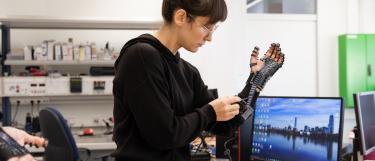
A mentor must be able to identify brilliant ideas
Facets of transfer
INF 368, a grey block from the sixties in Neuenheim Campus, not very spectacular from the outside. However, once you enter and reach the top floor you are in a different world. A spacious lab with a great view over the city and to the hills beyond, full of light and buzz and filled with numerous workstations, from carbon fiber 3D printers to sewing machines, covered with bits and pieces on their way to become robotic devices. It is the biorobotics lab of Lorenzo Masia and his team. Here, medical technology is being developed and tested at a high standard.
Lorenzo Masia, originally from Italy, came to Heidelberg University in 2019 as a full professor in medical technology and biorobotics. Johanna Schwarz from hei_INNOVATION visited him to chat about his scientific journey, about the way he does transfer and why it is so important to him.

Lorenzo, can you please tell us a little bit about yourself, such as the discipline you are working in, your scientific journey, your current role and your research interest?
I'm a mechanical engineer by training with specialization in biomedical engineering and everything that concerns applications in medical technology. This is also the name of the chair I am covering here at Heidelberg University. My journey was across three continents; I would say that I travelled a lot. I started my studies with the pioneering group in rehabilitation robotics at MIT, where I spent two years. Then, in 2007, I became a team leader at the Italian Institute of Technology in the Department of Robotics Brain and Cognitive Sciences. I started my academic path at the Nanyang Technological University of Singapore in 2013 where I did my tenure track as Assistant Professor and successively I was Associate Professor in Biodesign at the University of Twente in the Netherlands in 2018. At last, I assumed duty as a full professor in Biorobotics and Medical Technology here at Heidelberg University in April 2019.
I deal mostly with the design and development of machines interacting with humans, focusing on rehabilitation, physical assistance, and augmentation. We design most of our technology in house such as sensors, actuators and wearable devices. My team is able to code all the parts related to the control algorithms for driving such devices, which is, I believe, the part in which my team is nowadays at the forefront: these activities concern the control software devoted to safely mastering the physical interaction between the wearable robots and the humans. We have experience in testing our technology in industry settings as well as in clinics.
Which projects of yours address technology transfer?
There are two main research pillars: clinical application for assistance and rehabilitation and human augmentation and wellness. For both, we are using more or less the same technology that is scaled up or down, depending on the application. Some examples are systems that assist during industrial tasks such as lifting in logistics, by reducing the effort and thus preventing musculoskeletal disorders; wellness is another realm in which our systems for walking assistance can assist someone who wants to exercise longer and with higher endurance.
Which aspects of transfer did you cover?
Actually, everything related to the design and conception of the mechanisms and of the software that regulates the interaction between wearable machines and users. There's a big part of it in the mechanical design that is actually my background, but there's also a major contribution in novel control strategies. This is the core of the technology development that I usually try to transfer.
What is the meaning of technology transfer to you from a personal perspective?
There are two meanings. The first is probably the most common reply: delivering a technology that has a societal impact. However, I find this kind of definition a bit simplistic because “transfer” has a multifaceted exploitation. The meaning of transfer to me is also preparing persons, who are mentored by me, to have an impact on the society with the skills that they apprehend once they are inside this institution, and successively transfer their technological capacity and working ethics somewhere else. Usually, a person in my group does not remain with me for more than three or four years (PhD or postdoc); afterwards she or he must get a position elsewhere on a higher-level institution or working group. So this to me is the double meaning of transfer: societal impacts and impact on the life of people who are trained here under my responsibility.

Can you share with us your motivation to invest time and effort into technology transfer projects on top of everything else you already do?
Well, first of all, it is related to what my students or my researcher will become after having spent time in my group. Not everyone wants to stay in academia, but might want to go out working in corporates or create their own companies. And this is also the meaning of transfer in academia to me. A mentor must be able to identify if someone in her/his group has a brilliant idea and help to promote this idea or prototype to a higher technological readiness level. For such a task we have luckily the support of the agency for innovation and transfer of our university which consistently plays a strong role in order to connect the university to the entrepreneurial world.
Thank you very much for the interview!
